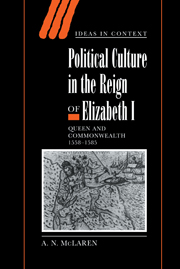Book contents
- Frontmatter
- Contents
- Acknowledgements
- Introduction
- 1 ‘To be Deborah’: the political implications of providentialism under a female ruler
- 2 Announcing the godly common weal: Knox, Aylmer and the parameters of counsel
- 3 Feats of incorporation: the ideological bases of the mixed monarchy
- 4 Contesting the social order: ‘resistance theory’ and the mixed monarchy
- 5 Godly men and nobles: the bicephalic body politic
- 6 Godly men and parliamentarians: the politics of counsel in the 1570s
- 7 Rewriting the common weal: Sir Thomas Smith and the De Republica Anglorum
- Afterword
- Bibliography
- Index
- IDEAS IN CONTEXT
3 - Feats of incorporation: the ideological bases of the mixed monarchy
Published online by Cambridge University Press: 06 August 2009
- Frontmatter
- Contents
- Acknowledgements
- Introduction
- 1 ‘To be Deborah’: the political implications of providentialism under a female ruler
- 2 Announcing the godly common weal: Knox, Aylmer and the parameters of counsel
- 3 Feats of incorporation: the ideological bases of the mixed monarchy
- 4 Contesting the social order: ‘resistance theory’ and the mixed monarchy
- 5 Godly men and nobles: the bicephalic body politic
- 6 Godly men and parliamentarians: the politics of counsel in the 1570s
- 7 Rewriting the common weal: Sir Thomas Smith and the De Republica Anglorum
- Afterword
- Bibliography
- Index
- IDEAS IN CONTEXT
Summary
It is the whole social order, not merely monarchy, which God hath ordained.
Thomas Starkey, An Exhortation to the People (1536)In Tudor England, John Guy dates the emergence of the concept of the ‘state’ in its modern sense, in England, to the second half of Elizabeth's reign. He sees the deeply ambiguous legacy of Henry VIII's break with Rome with regard to church government as fundamental to this development. As evidence he notes that Henry VIII employed as propagandists two men whose outlooks and conclusions on the definition of imperial sovereignty were ‘so fundamentally different that they could not both be right’: the caesaropapist Edward Foxe, and Christopher St German, proponent of parliamentary sovereignty in spiritual matters. Yet, as he observes, ‘Foxe's theory was muzzled by Elizabeth's Privy Council’. Instead, ‘leading Protestant politicians such as Burghley, Lord Keeper Bacon, Leicester, Walsingham, and the earls of Bedford and Pembroke preferred the option of limiting the powers of the Crown’.
Given contemporary beliefs about the dangers of female rule, we must ask how much choice they had in identifying England in such a way that the powers of the crown could be limited, pre-eminently by being defined as separable from the person of the monarch. It does not detract from John Aylmer's intellectual achievement to recognise the political necessity to which he responded in articulating his conception of the mixed monarchy. Fears of a ‘monstrous regiment’ virtually dictated that during Elizabeth's reign England would be defined as a corporation, with imperial sovereignty residing in queen-in-parliament.
- Type
- Chapter
- Information
- Political Culture in the Reign of Elizabeth IQueen and Commonwealth 1558–1585, pp. 75 - 104Publisher: Cambridge University PressPrint publication year: 1999



